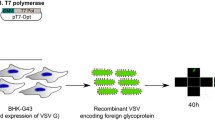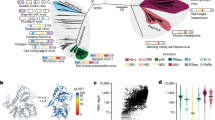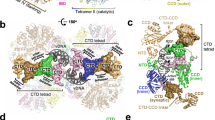Abstract
Lentiviral (LV) vectors have emerged as powerful tools for basic research and clinical applications because of their ability to stably transduce both dividing and nondividing cells. A wide range of viral envelope (Env) glycoproteins have the ability to associate with the membrane of LV vectors, a process that is referred to as pseudotyping. Pseudotyped vectors have the capacity to transduce specific cell types for specific applications. For example, LV vectors pseudotyped with the measles virus (MV)-derived hemagglutinin (H) and fusion (F) proteins have the ability to transduce quiescent lymphocytes. In addition, the MV H glycoprotein can be engineered allowing cell-specific targeting of LV vectors. One problem with MV glycoprotein-pseudotyped LV vectors is low titer during vector production. This results in the need to manufacture large volumes of the vectors and to concentrate them to appropriate titers. The commonly used centrifugation-based concentration techniques for LV vectors are not practical for large-scale vector manufacturing. Thus, there is a need for improved methods to concentrate LV vectors. In this study, we adapted an anion-exchange membrane chromatography method that we previously used in the context of LV vectors pseudotyped with the vesicular stomatitis virus glycoprotein to concentate MV glycoprotein-pseudotyped LV vectors. Up to 60% of the input vectors with an up to 5300-fold reduction in volume was achieved using this anion-exchange chromatography method in conjunction with a desalting/concentration step involving centrifugal filter units. This technique provides a rapid and scalable approach for concentrating MV-pseudotyped LV vectors that does not require an elaborate setup.
This is a preview of subscription content, access via your institution
Access options
Subscribe to this journal
Receive 6 print issues and online access
$259.00 per year
only $43.17 per issue
Buy this article
- Purchase on SpringerLink
- Instant access to full article PDF
Prices may be subject to local taxes which are calculated during checkout



Similar content being viewed by others
References
Cronin J, Zhang XY, Reiser J . Altering the tropism of lentiviral vectors through pseudotyping. Curr Gene Ther 2005; 5: 387–398.
Bischof D, Cornetta K . Flexibility in cell targeting by pseudotyping lentiviral vectors. Methods Mol Biol 2010; 614: 53–68.
Frecha C, Levy C, Cosset FL, Verhoeyen E . Advances in the field of lentivector- based transduction of T and B lymphocytes for gene therapy. Mol Ther 2010; 18: 1748–1757.
Yanagi Y, Takeda M, Ohno S . Measles virus: cellular receptors, tropism and pathogenesis. J Gen Virol 2006; 87: 2767–2779.
Buchholz CJ, Muhlebach MD, Cichutek K . Lentiviral vectors with measles virus glycoproteins - dream team for gene transfer? Trends Biotechnol 2009; 27: 259–265.
Humbert JM, Frecha C, Amirache Bouafia F, N'Guyen TH, Boni S, Cosset FL et al. Measles virus glycoprotein-pseudotyped lentiviral vectors are highly superior to vesicular stomatitis virus G pseudotypes for genetic modification of monocyte- derived dendritic cells. J Virol 2012; 86: 5192–5203.
Funke S, Maisner A, Muhlebach MD, Koehl U, Grez M, Cattaneo R et al. Targeted cell entry of lentiviral vectors. Mol Ther 2008; 16: 1427–1436.
Anliker B, Abel T, Kneissl S, Hlavaty J, Caputi A, Brynza J et al. Specific gene transfer to neurons, endothelial cells and hematopoietic progenitors with lentiviral vectors. Nat Methods 2010; 7: 929–935.
Munch RC, Muhlebach MD, Schaser T, Kneissl S, Jost C, Pluckthun A et al. DARPins: an efficient targeting domain for lentiviral vectors. Mol Ther 2011; 19: 686–693.
Ou W, Marino MP, Suzuki A, Joshi B, Husain SR, Maisner A et al. Specific targeting of human interleukin (IL)-13 receptor alpha2-positive cells with lentiviral vectors displaying IL-13. Hum Gene Ther Methods 2012; 23: 137–147.
Zhou Q, Schneider IC, Edes I, Honegger A, Bach P, Schonfeld K et al. T-cell receptor gene transfer exclusively to human CD8(+) cells enhances tumor cell killing. Blood 2012; 120: 4334–4342.
Abel T, El Filali E, Waern J, Schneider IC, Yuan Q, Munch RC et al. Specific gene delivery to liver sinusoidal and artery endothelial cells. Blood 2013; 122: 2030–2038.
Funke S, Schneider IC, Glaser S, Muhlebach MD, Moritz T, Cattaneo R et al. Pseudotyping lentiviral vectors with the wild-type measles virus glycoproteins improves titer and selectivity. Gene Ther 2009; 16: 700–705.
Marino MP, Kutner RH, Lajmi A, Nochumson S, Reiser J . Development of scaleable purification protocols for lentiviral vectors. Mol Ther 2003; 7: S178–S179.
Slepushkin V, Chang N, Cohen R, Gan Y, Jiang B, Deausen E et al. Large-scale purification of a lentiviral vector by size exclusion chromatography or Mustang Q ion exchange capsule. Bioprocess J 2003; 2: 89–95.
Kutner RH, Puthli S, Marino MP, Reiser J . Simplified production and concentration of HIV-1-based lentiviral vectors using HYPERFlask vessels and anion exchange membrane chromatography. BMC Biotechnol 2009; 9: 10.
Leath A, Cornetta K . Developing novel lentiviral vectors into clinical products. Methods Enzymol 2012; 507: 89–108.
Zimmermann K, Scheibe O, Kocourek A, Muelich J, Jurkiewicz E, Pfeifer A . Highly efficient concentration of lenti- and retroviral vector preparations by membrane adsorbers and ultrafiltration. BMC Biotechnol 2011; 11: 55.
McNally DJ, Darling D, Farzaneh F, Levison PR, Slater NK . Optimised concentration and purification of retroviruses using membrane chromatography. J Chromatogr A 2014; 1340: 24–32.
Kutner RH, Zhang XY, Reiser J . Production, concentration and titration of pseudotyped HIV-1-based lentiviral vectors. Nat Protoc 2009; 4: 495–505.
Lajmi AR, Kutner R, Reiser J . A membrane chromatography application: a rapid, high capacity gene therapy vector purification tool. In: Shukla AA, Etzel MR, Gadam S (eds) Process Scale Separations for the Biopharmaceutical Industry. CRC Press: Boca Raton, FL, 2007, pp 541–564.
Orr V, Zhong L, Moo-Young M, Chou CP . Recent advances in bioprocessing application of membrane chromatography. Biotechnol Adv 2013; 31: 450–465.
Moll M, Klenk HD, Maisner A . Importance of the cytoplasmic tails of the measles virus glycoproteins for fusogenic activity and the generation of recombinant measles viruses. J Virol 2002; 76: 7174–7186.
Takeda M, Tahara M, Hashiguchi T, Sato TA, Jinnouchi F, Ueki S et al. A human lung carcinoma cell line supports efficient measles virus growth and syncytium formation via a SLAM- and CD46-independent mechanism. J Virol 2007; 81: 12091–12096.
Noyce RS, Bondre DG, Ha MN, Lin LT, Sisson G, Tsao MS et al. Tumor cell marker PVRL4 (nectin 4) is an epithelial cell receptor for measles virus. PLoS Pathog 2011; 7: e1002240.
Cooper AR, Patel S, Senadheera S, Plath K, Kohn DB, Hollis RP . Highly efficient large-scale lentiviral vector concentration by tandem tangential flow filtration. J Virol Methods 2011; 177: 1–9.
Bandeira V, Peixoto C, Rodrigues AF, Cruz PE, Alves PM, Coroadinha AS et al. Downstream processing of lentiviral vectors: releasing bottlenecks. Hum Gene Ther Methods 2012; 23: 255–263.
Kuroda H, Kutner RH, Bazan NG, Reiser J . Simplified lentivirus vector production in protein-free media using polyethylenimine-mediated transfection. J Virol Methods 2009; 157: 113–121.
Kuroda H, Marino MP, Kutner RH, Reiser J . Production of lentiviral vectors in protein-free media. Curr Protoc Cell Biol 2011; Chapter 26: Unit26.8.
Zhang XY, La Russa VF, Reiser J . Transduction of bone-marrow-derived mesenchymal stem cells by using lentivirus vectors pseudotyped with modified RD114 envelope glycoproteins. J Virol 2004; 78: 1219–1229.
Acknowledgements
This project was supported in part by an appointment of MP and JM to the Research Participation Program at the Center for Biologics Evaluation and Research administered by the Oak Ridge Institute for Science and Education through an interagency agreement between the US Department of Energy and the US Food and Drug Administration. We are grateful to Linyi Zhang for help with the cell viability assay. We thank Robert Aksamit (FDA/CBER) and Zhili Xu (FDA/CBER) for helpful comments on the manuscript.
Author information
Authors and Affiliations
Corresponding author
Ethics declarations
Competing interests
The authors declare no conflict of interest.
Rights and permissions
About this article
Cite this article
Marino, M., Panigaj, M., Ou, W. et al. A scalable method to concentrate lentiviral vectors pseudotyped with measles virus glycoproteins. Gene Ther 22, 280–285 (2015). https://doi.org/10.1038/gt.2014.125
Received:
Revised:
Accepted:
Published:
Issue date:
DOI: https://doi.org/10.1038/gt.2014.125
This article is cited by
-
Patient fibroblast circadian rhythms predict lithium sensitivity in bipolar disorder
Molecular Psychiatry (2021)



